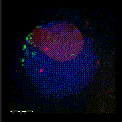


ABSTRACT & LINKS

Bass HW, Bordoli SJ, Foss EM (2002)
The desynaptic (dy) and desynaptic1 (dsy1)
mutations in maize (Zea
mays L.) cause distinct telomere-misplacement phenotypes during
meiotic prophase.
Journal of Experimental Botany 54(380):39-46.
[
PubMed ID 12456753
|
J Exp Bot online
|
3D-Movies
|
Movie Mirror
|
PDF
]
ABSTRACT:
During meiotic prophase, telomeres actively attach themselves to the nuclear
envelope and cluster in an arrangement called the bouquet. The bouquet is
unique to meiosis, highly conserved, and thought to facilitate homologous
chromosome synapsis. Analysis of three-dimensional fluorescence in situ
hybridization (3-D FISH) image data has been employed to characterize the
bouquet in fixed pollen mother cells of maize (Zea mays L.). In order to
examine further the function of the bouquet, we screened several meiotic
mutants for telomeric defects using 3-D FISH as an assay. Two mutants,
desynaptic (dy) and desynaptic1 (dsy1), were found to exhibit novel telomere-
misplacement phenotypes. In both cases, the telomere-associated mutant
phenotypes occurred prior to what was previously reported as the earliest
affected stage. Three alleles of the desynaptic1 mutation (dsy1-1, dsy1-9101,
and dsy1-9307) resulted in a partial bouquet phenotype at the zygotene stage
of meiotic prophase. In contrast, dy nuclei contained apparently normal
bouquets but then resulted in a premature intranuclear localization of
telomeres at the pachytene stage, when telomeres normally disperse but remain
attached to the nuclear envelope. The dsy1 mutation is known to impair the
fidelity and progression of homologous synapsis, whereas the dy mutation is
known to reduce recombination rates. If the telomere misplacements are
primary defects of these mutants, then these data would be consistent with
the hypothesis that meiotic telomeres have at least two separable functions,
one involving proper homologous chromosome synapsis at the bouquet stage and
another involving postbouquet crossover control.
back to pubs page
 HOME
HOME





HOME